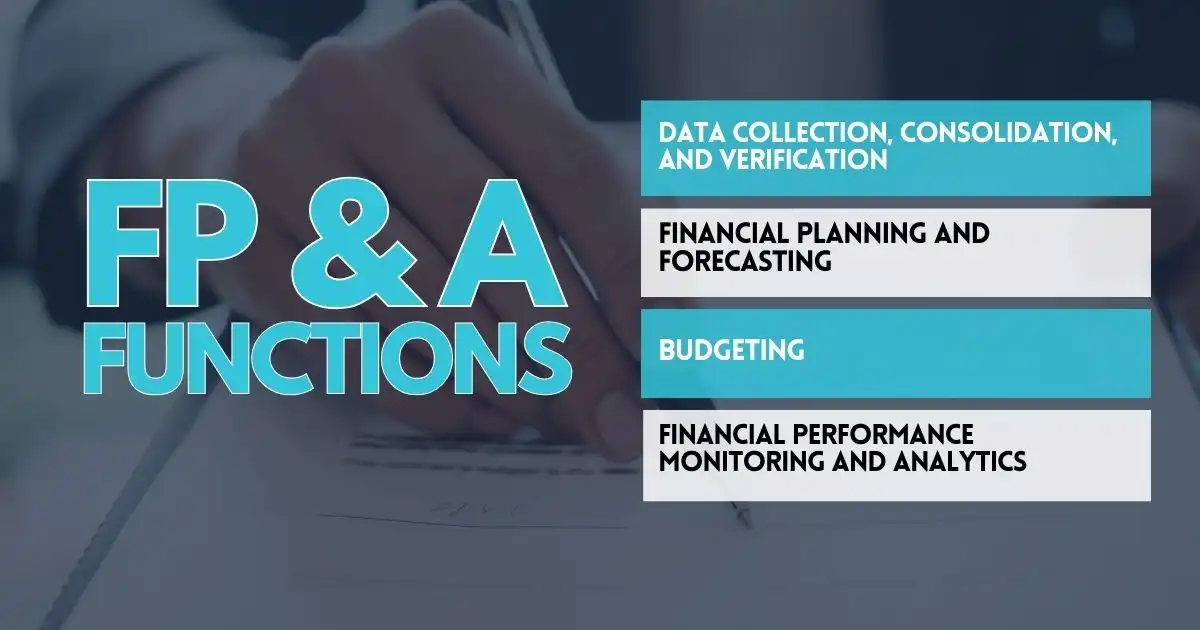When running a successful business, numbers tell a story — and FP&A (Financial Planning and Analysis) is the team that knows how to read it, write it, and plan the next chapter.
FP&A isn’t just about crunching spreadsheets or producing reports. It’s about shaping a company’s future by turning raw data into real strategy. From budgeting and forecasting to guiding big financial decisions, FP&A is at the heart of smarter, faster business growth.
Understanding the true role of FP&A opens the door to better performance, stronger financial health, and lasting success.
But what exactly does FP&A involve — and why has it become such a critical function for modern businesses?
What is FP&A (Financial Planning & Analysis)?
Financial Planning and Analysis refers to a set of important activities, such as planning, budgeting, forecasting, and analysis, that help maintain a company’s financial health and support its growth.
FP&A includes both everyday tasks like financial close and consolidation, cash flow reporting, and financial reporting, as well as strategic activities like integrated financial planning, scenario planning, forecasting, and financial modeling. When done well, FP&A not only explains a company’s past performance but also helps guide its future decisions.
Why is FP&A important?
Finance plays a role in almost every part of a business. While the broader Finance department handles tasks like record keeping, accounting, payroll, compliance, risk management, and investor relations, FP&A focuses on the future by helping to measure and guide a company’s financial performance.
The real value of the FP&A team comes from providing insights by analyzing financial and operational data for executives and the wider organization.
From planning headcount to making budget decisions, FP&A strongly influences a company’s culture, growth, direction, and overall success. To do this well, FP&A teams must clearly understand both the short-term and long-term financial needs of the company.
FP&A Functions

The FP&A process involves the continuous collection and analysis of data. It can be divided into four main parts:
1. Data Collection, Consolidation, and Verification
The first step is to gather financial and operational data from all business units, ERP systems, data warehouses, and internal departments. It is also important to collect relevant external data, such as market trends, economic indicators, and demographic information.
Once collected, the data must be consolidated and organized to make it easier to work with. After consolidation, the FP&A team standardizes and verifies the data, checking for errors to ensure accuracy. Since this process can be time-consuming, many teams use automation or AI-powered tools to speed up and improve data verification.
2. Financial Planning and Forecasting
After the data is collected and verified, the next step is to create financial forecasts. These forecasts help answer important questions about the company’s future, such as:
- What will our financial position look like next year if current trends continue?
- How would changing certain variables affect our results?
- What could our financial situation be in five years?
- What economic factors might impact our growth?
FP&A teams use several methods for forecasting:
- Predictive Analytics – Using historical data to predict future outcomes.
- Driver-Based Planning – Identifying key factors that drive business success and planning around them.
- Multi-Scenario Planning – Creating different possible future scenarios and preparing strategies for each.
FP&A teams must collaborate closely with leaders from all departments to build realistic and effective plans. Senior management then uses these forecasts to set strategic goals, such as Net Dollar Retention (NDR) targets.
3. Budgeting
Once planning and forecasting are complete, FP&A teams create a budget. They estimate the capital needed based on projected revenues and actual financial performance. This budget serves as a financial guide for the company.
Expenses are allocated to different business units, and cash flow and revenue expectations are set. The FP&A team works with department leaders to consolidate individual budgets into a single, master company-wide budget.
Different budgeting methods can be used, depending on the organization. Many FP&A teams prefer zero-based budgeting, which requires regular review of all expenses to avoid overspending. Some teams also use continuous budgeting, updating forecasts regularly to stay responsive to changing market conditions.
Interestingly, about 86% of finance teams still use Excel for creating forecasts and budgets.
4. Financial Performance Monitoring and Analytics
FP&A is not a one-time process. Teams continually monitor financial performance across the company, analyzing data and providing regular updates.
They create reports and visualizations to help departments understand how the business is performing and how their work impacts overall results. Through this continuous monitoring, FP&A ensures that the company stays aligned with its financial goals and can adjust quickly when necessary.
FP&A Roles and Responsibilities
While the CFO typically leads the overall FP&A strategy, the department relies heavily on the daily work of team members, especially the FP&A analysts. An FP&A analyst focuses on understanding and influencing a company’s financial performance.
The common roles and responsibilities of an FP&A analyst include:

1. Financial Data Collection
FP&A analysts are responsible for gathering financial and operational data from internal departments and external sources. They consolidate and organize this information, ensuring it is clean and accurate before any analysis begins.
Because a large part of FP&A time is spent collecting and verifying data, many teams use automation and technology to improve efficiency.
2. Creating and Preparing Detailed Reports
Data alone is not enough; it must be analyzed to have value. FP&A analysts transform raw data into meaningful insights by creating reports such as profit and loss statements, board reports, and variance analyses.
They also build dashboards and financial models to help stakeholders monitor and understand company performance. These reports are updated regularly, especially during monthly financial close processes.
3. Managing Financial Databases
All collected data must be stored securely and kept organized.FP&A analysts manage financial databases, often using integrated software tools that connect to spreadsheets. Proper database management ensures data accuracy, which is critical for making sound business decisions.
4. Maximizing Operational Effectiveness
Beyond historical reporting, FP&A teams also focus on improving the company’s operations.
By analyzing key performance indicators (KPIs) and metrics like the “SaaS Magic Number,” they help leadership teams make better decisions about where to invest resources. Efficient FP&A teams automate routine tasks to spend more time on strategic analysis.

5. Creating Scenarios, Forecasts, and Future Models
A core responsibility of FP&A is to predict future business outcomes. They build growth scenarios and financial models to answer strategic questions posed by leadership, such as revenue projections with new hires or expected profitability under different market conditions. Accurate forecasting depends on strong data collection, analysis, and communication skills.
6. Budgeting
FP&A teams develop budgets at annual, quarterly, and monthly intervals.
They estimate revenues, expenses, cash flows, and financial metrics to guide the organization’s financial planning.
On a departmental level, they also allocate resources to different teams, such as sales and marketing, to support company initiatives.
7. Profit Margin Management
After setting budgets, FP&A monitors financial performance to ensure departments stay on track. They compare actual revenues and expenses to planned figures and assess which teams or products are generating the most profit.
Additionally, they analyze investments and working capital to identify new opportunities to improve profitability.
8. Additional FP&A Skills
Successful FP&A professionals also require strong communication and collaboration skills.
They must be able to work closely with other departments, explain financial data clearly, and sometimes lead projects or advise teams.
Data visualization and storytelling skills are important for presenting complex financial insights in a way that non-financial team members can easily understand.
Recommended FP&A Software
Here are some of the top FP&A software tools that help automate and improve the efficiency of the FP&A team’s work.
- Cube – Cube is the first spreadsheet-native FP&A platform. It serves as a central source of truth by connecting directly to your source systems and allowing easy data transfers to and from Excel or Google Sheets. Cube helps automate manual tasks, reduces errors, and allows FP&A teams to focus more on valuable analysis and forecasting.
- Microsoft Excel – Excel is a long-standing and trusted tool widely used by FP&A and finance professionals. Despite the many new solutions available, Excel remains popular due to its familiarity and flexibility. Many attempts to replace it have not been successful.
- Google Sheets – Google Sheets is a simple, accessible tool used across many industries, not just in finance. It is compatible with any device and offers certain features that Excel does not. Although finance teams often prefer Excel, Google Sheets makes data easier to access, share, and understand.
- Workday Adaptive Planning – Workday Adaptive Planning offers robust capabilities beyond just FP&A, making it a strong option for large organizations seeking a company-wide planning solution. However, it requires a lengthy implementation process and follows a “replace spreadsheets” approach, which may not suit every business.
- Anaplan – Anaplan is designed for large enterprises with strong IT support and is ideal for managing complex, large-scale financial transformations. Like Adaptive Planning, it is cloud-based, replaces traditional spreadsheets, and centralizes data across the organization. Its long implementation cycle should be considered when choosing a solution.
- Planful – Planful suits larger companies with sizable FP&A teams looking to expand their influence beyond finance. It offers an Excel-like platform for managing complex financial processes, automates data collection, and provides tools for automatic data validation.
- Vena Solutions – Vena is best for companies that benefit from structured FP&A processes. It offers pre-built planning solutions that can either be used as-is or customized to meet unique business needs, making it a flexible choice depending on available resources.
Strengthen Your Business Future with Strategic FP&A
Financial Planning and Analysis is more than just working with numbers — it’s the engine that drives smarter decisions, sustainable growth, and lasting success. A strong FP&A function gives businesses the insight and agility to adapt, compete, and thrive in any market condition.
By building powerful FP&A processes, choosing the right tools, and creating a culture of data-driven decision-making, companies can move beyond reacting to challenges — they can plan for them, shape outcomes, and lead with confidence.
The future favors the prepared. Now is the time to invest in your FP&A capabilities, implement smarter solutions, and turn your financial strategy into a foundation for long-term success.
FAQs
What does an FP&A analyst do?
An FP&A analyst focuses on helping businesses make smart financial decisions. They forecast revenue and expenses, analyze financial data, create detailed budgets, and support leadership with actionable insights. In short, an FP&A analyst ensures the company’s financial health is monitored, projected, and managed effectively.
What is FP&A in business?
FP&A, or Financial Planning and Analysis, in business refers to the team or process responsible for budgeting, forecasting, financial reporting, and strategic advising. The financial planning and analysis process flow typically involves gathering financial data, analyzing trends, creating models, and presenting reports that help business leaders make informed decisions.
What FP&A skills are important for success?
Strong FP&A skills include financial modeling, data analysis, budgeting, forecasting, and reporting. Professionals must also have strong communication skills to explain complex financial information clearly, as well as strategic thinking to align financial planning analysis strategies with broader business goals.
What are FP&A reports, and why are they important?
FP&A reports summarize key financial data like revenue, expenses, profit margins, and future projections. These reports are critical tools for leadership to assess current performance and adjust strategies. A strong financial planning and analysis process flow ensures these reports are accurate, timely, and aligned with the company’s overall strategy.
